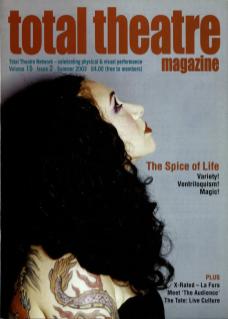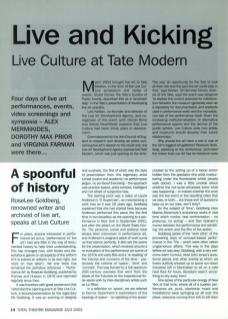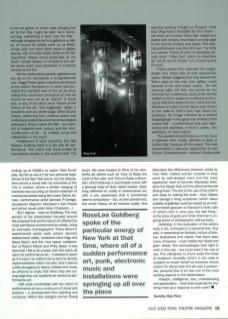For years, anyone interested in performance art (a.k.a. 'performance or live art') had very little in the way of documented history to help their understanding. This has changed now, with books and dissertations galore on all aspects of the artform (if it is indeed an artform in its own right, but more on that later!). Yet one book has remained the definitive reference – Performance Art by RoseLee Goldberg, published by Thames and Hudson in 1979 and reprinted regularly since then.
It was therefore with great excitement that I attended the opening event at Tate Live Culture, a lecture/presentation by the legendary Ms Goldberg. It was an evening of delights and surprises, the first of which was the style of presentation from this legendary artist turned curator and academic: no performance jargon, no po-faced theorising – the approach was practice-based, artist-centred, intelligent and not afraid of subjective bias.
The starting point was a video of Laurie Anderson's 'O Superman', as mesmerising a work now as it was 20 years ago. Goldberg explained that she had started here because Anderson performed this piece (for the first time in two decades) as the opening to a performance in New York in September 2001, just after the attack on the World Trade Centre. The personal, social and political have always been interwoven in performance art, and Anderson's poignant piece of work sums up that stance perfectly. It also set the scene for the presentation, which revolved around a re-evaluation of the performance art scene of the 1970s and early 80s and a 're-reading’ of the themes and concerns of the time – particularly the notions of 'space', 'time' and 'concept'. This was framed by a full-spectrum 20th century overview that went from the ideals of the Futurists to the inspirational fin-de-siècle work by interdisciplinary artists such as La Ribot.
In a reflection on 'space', we are referred to Dennis Oppenheim's explorations of the topology of space – 'an agitating of the space created by the setting up of a taboo action hidden from the spectator’ (the artist masturbating under the floorboards whilst people walk above). I was a little unclear about whether the not-quite-witnesses knew what was happening – or indeed whether the work was the live event or the resulting video that we saw, or both... but these sort of questions keep us on our toes, don't they?
On the subject of ‘time', Goldberg cites Marina Abramovic's endurance works in real time which involve 'real confrontation – no pretence, no acting – and Dan Graham's moves between live performance and exhibiting: the action and the film of the action.
Goldberg spoke of the ‘work ethic' of the pioneering days of concept-based performance in the 70s – which were often rather unglamorous affairs. This was in the days before art was sexy: Goldberg, with a very welcome warm humour, cited John Jonas' durational pieces and other events at which art lovers dutifully showed up to some run-down industrial loft in Manhattan to sit on a cold hard floor for hours. Boredom wasn't something to shy away from!
She spoke of the particular energy of New York at that time, where all of a sudden performance art, punk, electronic music and installations were springing up all over the place, everyone running from loft to loft then ending up at CBGB's to watch Patti Smith play. Her focus was on her own personal experience of the New York scene, but the descriptions struck a chord with my memories of the 70s in London, where a similar merging of interests was occurring (a random selection of intertwined artists being filmmaker Derek Jarman, performance artist Genesis P-Orridge, situationist Malcolm McClaren's Sex Pistols and art/sci visual artist Helen Chadwick...)
But I digress – back to Goldberg. The next section of her presentation focused around the proposal that performance art offered the most permissive environment for artists, citing as examples choreographer Trisha Brown's experimental aerial work (where dancers walked down walls), musicians John Cage and Steve Reich, and the 'new opera' collaboration of Robert Wilson and Philip Glass. It was here that I felt a bit uneasy with this catch-all claim for performance art – it started to seem as if it wasn't an artform but a term to denote experimentation within the arts. And it seems a little derogatory to dance, theatre and music as artforms to imply that when they are cutting-edge they can suddenly be viewed as performance art.
I felt more comfortable with the notion of performance art as a continuum of visual arts practice - a development from painting and sculpture. Within this category comes Zhang Huan. We were treated to films of his wonderful art pieces such as How to Raise the Level of the Lake and How to Raise a Mountain which features a countryside scene with a growing heap of (live) naked bodies. Goldberg reflected on nudity in performance art, with a wry awareness that it sometimes seems compulsory – but, as she pointed out, the whole history of art involves nudity. She discussed the differences between works by Yves Klein (naked women covered in blue paint by well-dressed men) and the more egalitarian work of feminist libertarian tricksters the Kipper Kids and the aforementioned Zhang Huan. This led to the use of the artist's own body in making the work – from Gilbert and George's living sculptures (which taken outside of galleries could be viewed as an anti-commercial gesture) to Manzoni's ironic sale of 'artist's shit' in cans (yes, the real thing – at the price of gold) and Cindy Sherman's ongoing series of photographic self-portraits.
Goldberg, in this evaluation of the artist's body in art, confessed to a personal bias. She said, in presenting her fantastic archive of photos, illustrations and videos, that there were many omissions – most notably the ‘blood and gore' artists. She acknowledged their right to work in this way – but it just wasn't her cup of tea. This willingness to chuck aside the cloak of academic neutrality (which in any case is suspect) to reveal herself as someone whose reason for doing what she did was a passionate, personal love of art was one of the most exciting aspects to the presentation.
Passion, intelligence, love, understanding and appreciation – what artist could ask for anything more as a response to their work?


